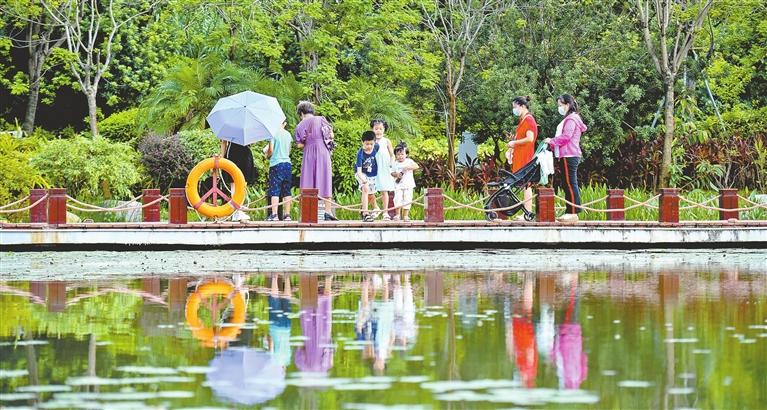
Residents have fun at Yanluo Wetland Park along the Maozhou River in this July 8 photo. Xinhua

A resident takes photos of spring blossoms at Guiwan Park in Nanshan District in this Feb. 22 photo. Xinhua

A “Zero-Waste City” event takes place on World Environment Day on June 5 in Shenzhen. Xinhua



Editor’s note:
As we reflect on 2024, Shenzhen remains committed to advancing high-level opening up, actively integrating into the new development pattern, and attracting foreign investment. We’re introducing this special series, “2024 in Review,” to highlight the city’s progress across various sectors. This marks the eighth installment in our series of reports.
In 2024, guided by its “Green and Beautiful Shenzhen: A City of Mountains, Sea, and Urban Harmony” vision, Shenzhen made significant strides in reducing carbon emissions, curbing pollution, expanding green spaces, and fostering sustainable growth. Shenzhen has taken bold steps toward creating a modern city where humans and nature coexist in harmony, setting an inspiring example of ecological modernization.
‘Green and Beautiful Shenzhen’ initiative
The State Council officially approved the Shenzhen Land Use Overall Plan (2021-2035) on Sept. 26, 2024, marking a significant step toward sustainable urban development. The plan drives the city’s “Green and Beautiful Shenzhen” initiative through six key actions aimed at integrating mountains, the sea, and urban areas into a cohesive ecological network. This effort includes the creation of a city-wide “one ridge, one belt, and 20 corridors” ecological framework.
A pioneer in digital energy
In 2024, Shenzhen unveiled the Digital Energy Pioneer City Development Plan (2024-2030), focusing on application scenarios, intelligent energy dispatch, and green electricity services to accelerate the transition to low-carbon energy systems. From January to November 2024, green electricity transactions reached 1.543 billion kilowatt-hours, increasing by 1.8 times year on year. In addition, both the transaction volume and the number of users in Shenzhen were the highest in Guangdong Province.
Low PM2.5 levels
In 2024, Shenzhen continued to excel in air quality management, with 97% of days meeting good air quality standards and 60.9% classified as excellent. The city’s PM2.5 concentration was maintained at an impressive 17.3 micrograms per cubic meter, securing the top spot in Guangdong Province and ranking third among 168 major cities nationwide.
Improved river water quality
Throughout the year, Shenzhen carried out 413 targeted tasks across six major water quality improvement initiatives, focusing on areas like the Maozhou River. Efforts included a wastewater pipeline improvement campaign, which saw 145.6 kilometers of drainage pipelines built or repaired, raising the city’s centralized wastewater collection rate to 85%.
These measures yielded significant results: all 21 water quality monitoring sections achieved excellent ratings under national and provincial standards. The proportion of excellent water bodies among the 310 monitored rivers has reached 82.8%, setting a new record.
Daya Bay named a ‘National Beautiful Bay’
The Ministry of Ecology and Environment announced the third batch of Beautiful Bay Excellence Cases and Beautiful Bay Listings, with Shenzhen’s Daya Bay earning a spot on the prestigious list.
The city implemented high-standard integrated bay management measures, maintaining Class I water quality in the eastern sea area and reducing the average total nitrogen concentration of rivers that flow into the western sea area by 12.8% year on year.
In 2024, high-quality progress was made in natural ecological conservation. The city restored 26.71 square kilometers of ecosystems, optimized 4,520 mu (3.01 square kilometers) of forest stands, and managed 29,349 mu (19.57 square kilometers) of forest resources.
‘Zero-Waste City’ pilot evaluation
Guangdong announced the results of its “Zero-Waste City” pilot evaluations in August 2024, with Shenzhen securing the top position. Shenzhen has launched key projects, such as the Guangming Environmental Park, and established five new green sorting centers, bringing its daily solid waste treatment capacity to 309,000 tons. To address noise pollution, Shenzhen installed over 500 remote-controlled noise-canceling devices at construction sites.
Pioneering carbon reduction products
In 2024, the city’s carbon market transaction volume exceeded 2.4 billion yuan (US$327 million). Notable firsts included the introduction of the nation’s first “Carbon Reduction Loan,” the launch of China’s first carbon asset securitization product, and the implementation of mangrove conservation carbon credit-backed financing. During the first three quarters of 2024, the city’s green and low-carbon industries generated an added value of 177.24 billion yuan, reflecting robust growth of 14.6% year on year.
Advancing eco-protection in GBA
In 2024, Shenzhen elevated cross-border environmental cooperation within the Guangdong-Hong Kong-Macao Greater Bay Area to a new level. Multiple landmark agreements were signed between Shenzhen and Hong Kong, including a comprehensive agreement to deepen ecological collaboration, a conservation framework for the Shenzhen Bay (Houhai) Wetland, and a framework for constructing an ecological corridor linking Shenzhen’s Wutong Mountain and Hong Kong’s Robin’s Nest Country Park.
Ecological innovations go national
Shenzhen’s leadership in ecological reforms gained national recognition in 2024, with two key initiatives being promoted across China. On May 15, the Ministry of Ecology and Environment named Shenzhen as a pilot city for advancing climate-adaptive urban development. Later, on Dec. 31, the National Development and Reform Commission issued a notice recognizing Shenzhen’s innovative measures as models for other regions.
‘Shenzhen practice’ goes viral
In 2024, the city hosted a traveling exhibition on Shenzhen’s ecological achievements, launched the “Green Development Salon” for public outreach, and organized eco-educational tours across the Shenzhen metropolitan area in collaboration with the cities of Dongguan and Huizhou.
Additionally, Shenzhen marked key days of environmental observance, such as International Day for Biological Diversity, World Environment Day, and National Ecology Day, with events like the Youth Environmental Festival and the Green Harmony Arts Festival, embedding green values in the public consciousness.
November 2024 marked a major milestone with the signing ceremony for the International Mangrove Center agreement in Shenzhen, officially launching its operations. The city also co-hosted the Guangdong session during the 29th United Nations Climate Change Conference (COP29).
分享到:
,https://www.sz.gov.cn/en_szgov/news/latest/content/post_11970216.html
